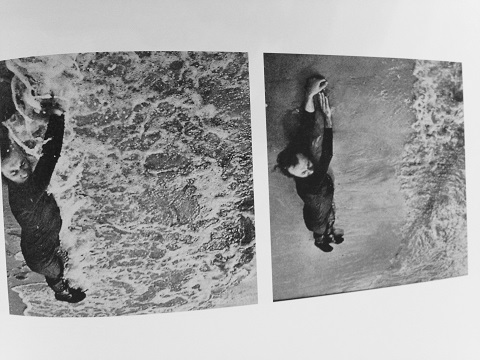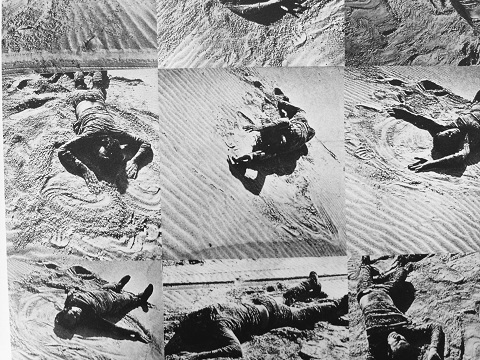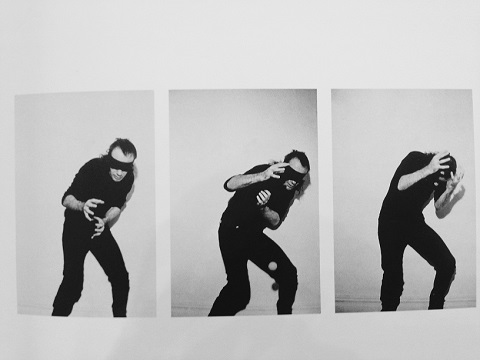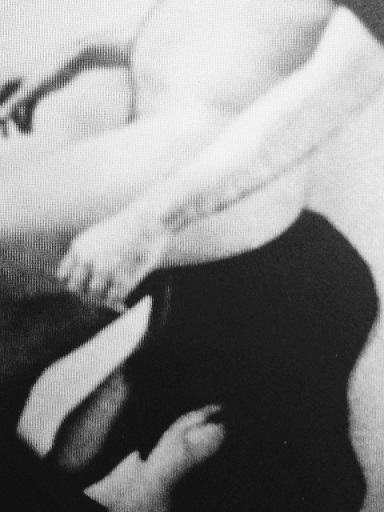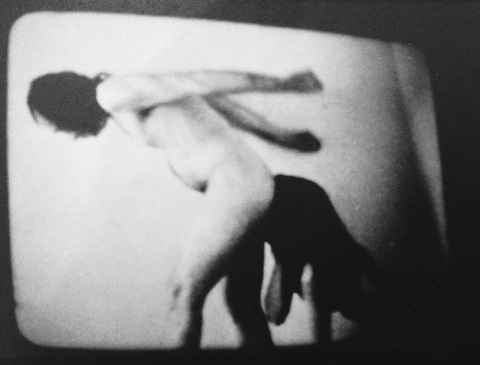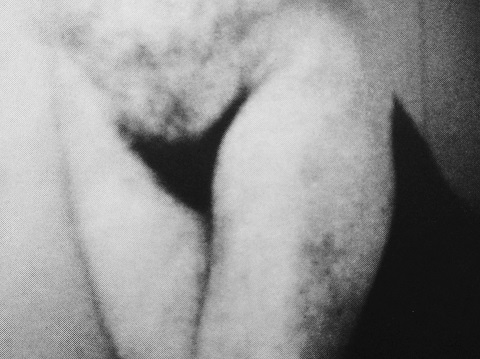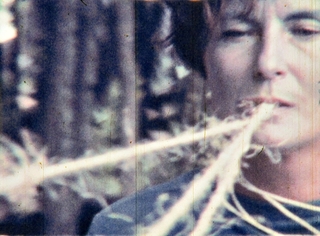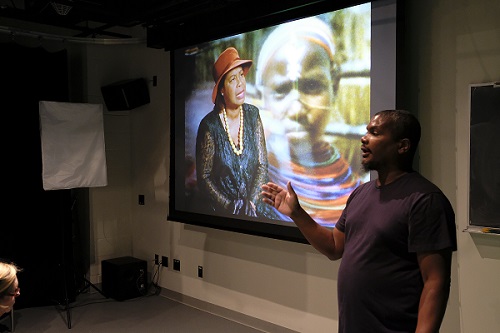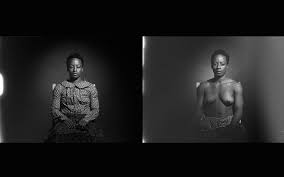by Lynne Sachs
It’s been one horrible beginning of the year in America, and as you read this piece you will certainly know more than I do about the first few days, weeks, months and (aargh!) years of a Trump presidency. After marching with hundreds of thousands of other women and men in Washington D.C. on January 21, 2017, I decided that I would put out a call for films of any kind that would become a publically accessible collection of moving image pieces we would call ‘Cinema of Resistance’. Through a public social media request, I asked people from anywhere in the world to send me their video-witnessing of the Women’s March, wherever they experienced it, and after that to send any manifestations of public challenges to the message and the actions of our new President. For this project, I am not necessarily looking for polished works by people who call themselves filmmakers, but rather documents of resistance, beginning with the Women’s March, by anyone with a camera. There are already a whole range of videos in the collection now, including powerful material from Red States like Alaska and Nebraska – real proof that oppositional viewpoints exist where you least expect them and most respect them. Take a look at the growing collection HERE and send your own YouTube links to me to add to the collection. [Please find my email address below.]
Cinema of Resistance, footage by Lynne Sachs from the Women’s March on Washington, 2017.
As a filmmaker and a long-term progressive activist, I have been thinking and talking about the connection between our media practice and the crisis that is our current political situation. From the environment to reproductive health to immigration, Donald Trump is trying to dismantle every aspect of the Obama legacy. And so, with this in mind, I decided to turn to a selection of performance related acts of resistance going back as far as the 1960s that have shaken my own Weltanschauung, and forced me to think about the responsibilities of an artist during times of tumult.
In Kazuo Ishiguro‘s novel An Artist of the Floating World (1986) a Japanese painter reflects on his life during and after World War II. In his candid first-person narration, Ishiguro‘s protagonist confronts his own complicity with the totalitarian state as a producer of propagandistic paintings. Once we as readers realize that the narrator is struggling to understand his own confusion about his relationship to the political and commercial institutions around him, we begin to compare his ambivalence to our own, as artists, citizens, and human beings.
This series of reflections represents my personal survey of political actions, films, and performances that push our understanding of the delicate, potentially explosive impact of art, specifically media, in repressive environments, states, and institutions.
On May 17, 1968 nine Vietnam War protesters, including a nurse, an artist and three priests, walked into a Catonsville, Maryland draft board office, grabbed hundreds of selective service records and burned them with homemade napalm. This disparate band of activists chose to break the law in a defiant, poetic act of civil disobedience – what I would call a performance piece with profound consequences. Led by renowned priests and brothers Daniel and Phillip Berrigan, the Catonsville Nine planned their action as a visual statement against the Vietnam War, knowing full well that their collective decision would lead to years of imprisonment. An integral part of their planning was their notification to the press. Each phase of the action was documented by a local television crew that had been notified well ahead of time. Without a bona fide news agency’s filming of this production, the political resonances of this visionary gesture would be lost to us now, almost a half-century later. Ever since I first saw this archival material, I knew that its importance would echo in both the world of politics and art, as a manifestation of a radical form of resistance. In 2001, I made Investigation of a Flame, an experimental documentary on the Nine’s action and the aftermath.
Investigation of a Flame by Lynne Sachs, 2001.
Around the same that the Catonsville Nine were encouraging a Baltimore television news crew to film their ritualized act of civil disobedience, performance artist Vito Acconci was producing his own form of self-reflexive photography-based disruptions. Last year, PS1/Museum of Modern Art presented an exhibition of Acconci’s media work in New York City, Where We Are (Who Are We Anyway?)
In a rare, extraordinarily comprehensive display of his autobiographical performance work, viewers were able to see a wide array of Acconci’s photo series and Super 8mm films. As his distributor Video Data Bank writes, Acconci “positioned his own body as the simultaneous subject and object of the work,” in a radical calling to question of male identity and hegemony. Looking back at his Drifts, for example, forces us to think about the current immigration blockades facing so many foreigners trying to enter the United States – legally – from Mexico to multiple countries in the Middle East. With the theme of OC’s “Cinemas of Resistance” in mind, I share three of Acconci’s works:
In 1970, Acconci created Drifts by documenting himself doing the following action:
- Rolling toward the waves as the waves roll toward me; rolling away from the waves as the waves roll away from me.
- Lying on the beach in one position, as the waves come up to varying positions around me.
- Using my wet body: shifting around on the sand, letting the sand cling to my body.
This eloquent series of photographs of Acconci’s body rolling in the waves slapping against the beach compels us to reflect upon the flow of human beings coming and going from sea to land, from nowhere to somewhere, from one country to the next – either with the same ease as the waves or struggling against artificial borders created by the whims of a state – be it only vaguely democratic or fully totalitarian.
In two Super 8mm films, Acconci again simultaneously performs and directs an action that forces us to think about the position of audience and actor. In Blindfolded Catching, we look at the complex relationship between a performer/entertainer and the spectators who are watching him. Acconci challenges the conventions of this relationship in a startlingly violent dynamic that makes us think about the activating presence of the camera in torture scenarios we’ve witnessed recently through public media from Abu Ghraib and Guantanamo.
Blindfolded Catching (Super 8 film, b/w, 3 min.,1970)
Fixed camera shoots me, full-body, standing blindfolded with my back to the wall; from off-screen, rubber balls are thrown at me, one at a time, over and over again. I’m trying to catch the ball I can’t see…I’m raising my arms up in front of my face, I’ve anticipated when the next ball will be thrown. I’m wrong, my motions are wasted. I’m hit by a ball, my body doubles over, it’s too late to protect myself.
And lastly, amongst the many thought-provoking films created by Vito Acconci in the early 1970s, I find Conversions to be one of the most fascinating interpretations of sexuality, pornography, and power. In this film, Acconci shakes up everything you know about male/female relations.
Conversions (Super 8mm film, b/w, 6 min., 1970)
Two naked bodies on the screen: we’re all bodies – my head is out of the film frame, her face is lost in my body. The camera jerks around us, zooms in and out, looking for the right shot. Kathy Dillon, kneeling behind me, takes my penis in her mouth. With my penis confined, with my penis gone, I’m exercising (running in place, kicking, bending, stretching, jumping) – all the while, she’s trying to keep my penis lost in her mouth. As the camera moves in front of us, as the camera zooms in to my groin, my body has a vagina.~Vito Acconci
I first saw the films of Marie Louise Alemann (1927 -2015) in a 2016 screening at Anthology Film Archives in New York City. This one-evening exhibition marked the premiere of her oeuvre in the United States, roughly 40 years after its creation in the mid-1970s. Alemann, an emigré from Germany, understood the potential that film had for articulating anger and resistance. Knowing that her work was created during Argentina’s “Dirty War”, a time in which military forces and death squads hunted down and killed left-wing dissidents, I was curious to see what kind of work she was able to create in this era of national dictatorship. In Autobiográfico 2 (1974), she filmed herself bound by ropes and then releasing herself in an act of sensual, self-appointed liberation.
While in Buenos Aires in 2010, I spent an afternoon talking with Narcisa Hirsch, who worked closely with Alemann, about Marabunta, their performance and corresponding film collaboration. A ‘marabunta’ is a gigantic Brazilian ant that lives in the Amazon. Hirsch explained that their interpretation of this small but ferocious insect “served as a metaphor for people eating everything that they could find in their way.” Hirsch, Alemann and the other women in their artist collective made a huge sculpture of a human skeleton and covered it with food. Inside the skeleton were live pigeons painted with fluorescent colors. They mounted this sculpture in Buenos Aires near the doors of a movie theater showing Antonioni’s film Blow-Up (1966), and all the audience members were forced to look at the sculpture as they exited the film theater. Because the collective filmed the day-long creation and spontaneous exhibition of the Marabunta, their act of defiance against the male-dominated European Art Cinema of the 1960s is available to us today. Since the movie-goers were encouraged to eat the food that comprised the sculpture, they became complicit participants in this “biting” yet hilarious production. On many levels, Alemann and Hirsch’s resulting experimental film becomes an early example of a kind of expanded cinema that would, in our own imaginations, cannibalize Antonioni’s more “bourgeois” production.
Marabunto film (16mm ) by Narcisa Hirsch, Marie Louise Alemann y Walther Mejía
In the spring of 2016, I attended Microscope Gallery’s Brooklyn screening exhibition of Florida-based experimental filmmaker Christopher Harris’ films. This was to be my first opportunity to see a selected program of Harris’ work while he was there to discuss those issues that are most near and dear to him as a maker. Harris’ films are visually arresting, politically provocative, and sensitive — rarely have I watched such a nuanced, ambitious series of films that make you think for the hours, days and years that follow. His films and installations offer a remarkable opportunity to think about the ways that personal cinema can challenge assumptions about the acquisition of historical knowledge. Harris’ radical approach to historiography itself places his performative works in a new category of cinema’s counter culture.
In Harris’ Hallimuhfack (2016), a performer lip-syncs to the actual voice of renowned African-American author and anthropologist Zora Neale Hurston as she describes her method of documenting early Black folk songs in her home-state of Florida. According to Harris, “The flickering images were produced with a hand-cranked Bolex so that the lip-sync is deliberately erratic and the rear-projected, grainy, looped recycled images of Masai tribesmen and women become increasingly abstract as the audio transforms into an incantation.”
In A Willing Suspension of Disbelief ( 2014), Harris “re-stages slave daguerreotype in order to examine scientific racism.” Both pieces embrace the challenges, unpredictability, and evanescence of 16mm filmmaking as a form of anachronistic “resistance” to the more commercial, precise high-production “values” of digital. By working with Black women performers who become collaborators in his charged resurrection of the past, Harris offers both his female actors and us as an audience the chance to examine and confront the evils of our shared American story.
And finally, I’ll address Julian Rosenfeldt’s Manifesto which I saw in early 2017 in perhaps the largest single-room exhibition space in New York City, the Park Avenue Armory. According to the catalogue, material for this 13-screen installation is drawn from the writings of Futurists, Dadaists, Fluxus artists, Suprematists, and Situationists. Rosenfeldt weaves together their ideas with the musings of individual artists, resulting in a collage of artistic declarations. Hollywood actress Cate Blanchett performed all thirteen different protagonists as each screen attempts to articulate a contemporary call to action. Manifesto is by far the grandest, most expensive, most polished of the film works I have discussed in this essay. Clearly, critics, curators and the European and American art-going public are keen on celebrating the theoretical and historical foundations on which the Rosenfeldt builds his query into historical, political and social dialectics. We learn a great deal about the echoes of a fantastic array of thinkers, but do we come away from this work ready to engage with the world? In the exhibition catalogue, it seems to me, the emphasis is on the work’s “style that beautifully pays tribute to iconic film directors,” rather than to the ideas that he is ostensibly embracing. This is, sadly, a cinema about resistance but not a cinema of resistance.
I first met Father Daniel Berrigan (1921 – 2016), the Jesuit priest whose defiant protests helped shape a bold, grass-roots opposition to the Vietnam War, in 1998 when I was making Investigation of a Flame (2001). Little did I know that my interview with him about his role in the Catonsville Nine would lead to one of the deepest and most meaningful friendships of my life. Daniel was a poet and an activist, and both of these aspects of his being contributed to his life-long commitment to speaking out against injustice. Today, in this America of 2017, all of us must grapple with how to integrate our creative work into our lives as politically engaged members of a society in a disturbing moment of flux. We can certainly turn to the films of Acconci, Alemann, Harris and others as examples of work that expand our understanding of the way that a moving image – be it elliptical or explicit – can become a spark for thinking and action.
Note on Title: “This Machine Kills Fascists” is a message that Woody Guthrie placed on his guitar in 1941,which inspired many subsequent artists.
To be included in our Cinema of Resistance collection, upload your video to YouTube and send your link to:


